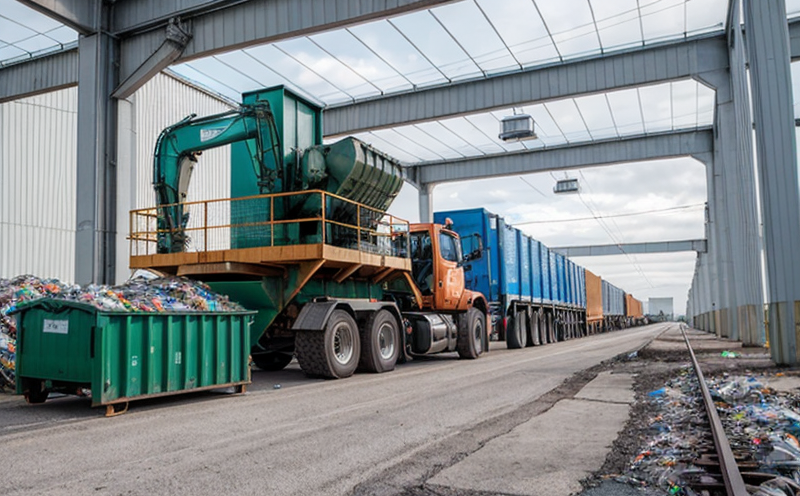EN 13430 Packaging Material Recoverability Testing
The European standard EN 13430 sets forth specifications and procedures to determine the recoverability of packaging materials, particularly those intended for reuse or recycling. This testing is crucial in ensuring that packaging contributes positively to the circular economy by facilitating efficient recovery processes.
Recoverability refers to the ability of a material to be recovered after use, typically through sorting, separation, and processing into raw materials suitable for remanufacture. Packaging materials need to meet stringent criteria to ensure they can undergo these processes without significant degradation or loss of quality. This standard is particularly important in sectors like consumer goods, electronics, and pharmaceuticals where packaging plays a critical role in product protection and environmental sustainability.
The testing process involves several key steps that are essential for compliance with EN 13430:
- Material Identification: The first step is to identify the material used in the packaging. This helps in understanding its potential for recovery and recycling.
- Sorting Simulation: Packaging samples undergo sorting simulations to mimic real-world conditions, ensuring they can be sorted effectively during post-consumer collection processes.
- Separation Efficiency: The efficiency of separating the packaging material from other waste streams is tested. This includes evaluating how well the material can be isolated for recycling or reuse purposes.
- Material Quality: The quality of recovered materials after sorting and separation is analyzed to ensure they meet specified standards for reprocessing into new products.
- Technical Feasibility: The test assesses whether the packaging material can be technically processed back into a form suitable for use in manufacturing new products.
The testing process requires precise sample preparation and handling to ensure accurate results. Samples are typically collected from representative waste streams, ensuring they reflect real-world conditions. The chosen samples undergo rigorous testing using specialized equipment designed to simulate the sorting and separation processes that packaging materials must endure during recycling.
Compliance with EN 13430 is not just a regulatory requirement but also a strategic move for businesses aiming to reduce environmental impact, enhance brand reputation, and meet consumer expectations. By ensuring packaging recoverability, companies can contribute significantly to the circular economy, promoting sustainability across supply chains.
Scope and Methodology
The scope of EN 13430 Packaging Material Recoverability Testing is broad and covers various aspects of material recovery. It applies to all types of packaging materials used in industrial manufacturing processes. The standard ensures that the tested materials can be sorted, separated, and processed into new products without significant loss of quality or technical feasibility.
The methodology involves several key steps:
- Sample Selection: Samples are selected from actual waste streams to ensure they reflect real-world conditions. This helps in assessing the practicality and effectiveness of recovery methods.
- Sorting Simulation: The samples undergo sorting simulations to mimic the processes used in post-consumer collection systems. This step evaluates how well materials can be sorted for recycling.
- Separation Efficiency Testing: The efficiency of separating packaging materials from other waste streams is tested using specialized equipment. This ensures that the material can be isolated and processed effectively.
- Material Quality Assessment: After sorting and separation, the quality of recovered materials is assessed to ensure it meets specified standards for reprocessing into new products.
- Technical Feasibility Analysis: The test evaluates whether the packaging material can be technically processed back into a form suitable for use in manufacturing new products. This includes assessing the technical processes required and their feasibility.
The testing process is conducted using standardized equipment and procedures to ensure consistency and accuracy across different laboratories. Compliance with these standards ensures that the results are reliable and can be used to make informed decisions about material selection and waste management practices.
Benefits
- Enhanced Sustainability: Ensures compliance with international standards, promoting environmental responsibility.
- Regulatory Compliance: Helps businesses meet regulatory requirements and avoid penalties associated with non-compliance.
- Brand Reputation: Demonstrates a commitment to sustainability, enhancing brand reputation among environmentally conscious consumers.
- Sustainable Manufacturing Practices: Aids in the development of sustainable manufacturing practices by identifying materials that can be effectively recovered and reused.
- Cost Savings: Reduces waste disposal costs by promoting recycling and reuse of packaging materials.
- Innovation Opportunities: Encourages innovation in material design, leading to more efficient and eco-friendly packaging solutions.
Industry Applications
- Consumer Goods Industry: Ensures that packaging used for consumer products can be effectively recovered and reused, contributing to sustainability goals.
- Electronics Industry: Helps in designing packaging materials that are easier to recycle, reducing electronic waste and promoting a circular economy.
- Packaging Manufacturers: Provides essential data for material selection and process optimization, ensuring high-quality recycled products.
- Retailers: Assists retailers in meeting sustainability targets by selecting packaging materials that can be effectively recovered and reused.
- Regulatory Bodies: Supports regulatory bodies in setting standards for packaging recoverability, promoting a more sustainable industry.





